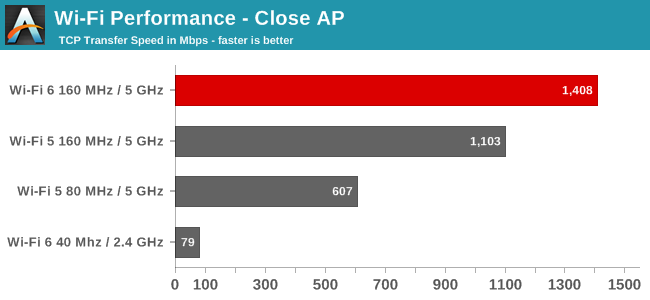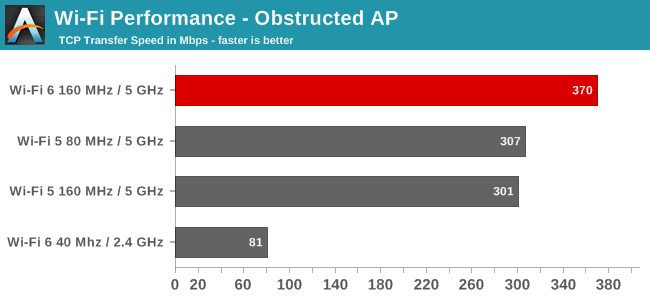AT 101: Wi-Fi 6 And Why You Want It
by Brett Howse on February 12, 2020 8:00 AM ESTPerformance
In order to achieve maximum performance, the latest Wi-Fi 6 standard leverages 1024-level QAM, but depending on the signal strength and quality it will scale down as needed, so to achieve the best performance very high signal to noise ratios are going to be required. Since 5 GHz is attenuated dramatically when it has to go through walls, if you need maximum Wi-Fi performance be aware that you are going to want your wireless router as close to the end device as possible. Luckily that is not an issue in our case, since the router is in the same room when testing for maximum performance, but we’ll also evaluate it in less than ideal scenarios as well.
Wi-Fi 5 vs Wi-Fi 6 – Close AP
First up we’ll test the TCP performance when the Access Point is in the same room as the client.

The performance advantages of Wi-Fi 6 are clear. With the access point in the same room, the SNR is very good and the new 802.11ax standard can really shine. With 1024 QAM and 160 MHz channels, the performance is over twice as fast as the outgoing Wi-Fi 5 with 256 QAM and 80 MHz channels. It is very impressive to see a typical 2x2:2 connection well over the Gigabit barrier, and even though the AX200 network card is the first generation, Intel has already done a fantastic job tuning it. The theoretical maximum transfer rate with 160 MHz channels and 1024 QAM is around 1200 Mbps per connection, so a 2x2 can in theory hit around 2.4 Gbps, meaning there's still room for improvement. Since 802.11ax also can be used on the 2.4 GHz frequency, unlike 802.11ac, the same test was also done on 2.4 GHz, and the results were disappointing. 2.4 GHz can still offer 40 MHz channels, but it doesn’t seem like the AX200 could take advantage of any of that. For reference, the wireless adapter in the laptop was reporting -21 dBm, which is a strong signal, which makes sense since the AP is almost right next to the laptop.
Wi-Fi 5 vs Wi-Fi 6 – Reduced Signal
Moving the laptop further away, and adding several walls and doors in the way to attenuate the signal, the same scenarios were again tested.

With some walls in the way, 5 GHz gets attenuated quite dramatically, and the SNR in the second location was -78 dBm. With such a low signal, the Wi-Fi 6 connection wasn’t able to take advantage of the 1024-level QAM and would have had to drop down to a much lower set, reducing the number of bits per tone, and even though the total channel bandwidth was still 160 MHz, it was only marginally faster on 802.11ax than 802.11ac 80 MHz. 2.4 GHz is not as impacted by walls, and as such was able to maintain the same transfer rate, even though it was still quite a bit slower.
So the results are clear. Wi-Fi 6 can offer a significantly higher level of throughput than Wi-Fi 5, but in order to do so, it needs a strong signal. The Wi-Fi 6 still outperformed the Wi-Fi 5 in the second test with an attenuated signal, but the performance gain was minimal. 2.4 GHz still offers the best signal strength, and therefore would be able to connect further away, and through more obstacles, but doesn’t offer anywhere near the performance of the 5 GHz range. It will be interesting to see the Wi-Fi 6E devices with 6 GHz support when they launch. It will open up Wi-Fi to a wider set of frequency choices, but will offer even less range.










149 Comments
View All Comments
Impulses - Thursday, February 13, 2020 - link
Is internet that fast really only available to 10% of the US population or was that an off the cuff "stat"...I'm surprised it's still that bad if that's accurate, I used to weep along with everyone else when I'd see comments like this but I've had 1Gbps (up/down) fiber at home for over a year now in a US territory that isn't exactly known for having it's stuff/infrastructure together (Puerto Rico)... For $70/month, no clue how competitive that is but it's affordable enough for me and well worth it (nor any more expensive than a lower speed package from the cable ISP).
Cable company is doing it's own fiber rollout to compete and they already offer 500Mbps over coax (tho 250-300Mbps is really what's sanely priced, the premium for the top tier isn't worth it). I was actually complacent with my 250mbps service with them but I'm glad to see some competition in the market.
Obviously those services aren't available island wide tho, I really dunno what % the rollouts are at... The fiber ISP has taken an interesting approach where they poll neighborhoods to decide where to build next.
oynaz - Friday, February 14, 2020 - link
1Gbps internet is around 50 euro/month in quite a few parts of Europe.Makaveli - Wednesday, February 12, 2020 - link
The GT-AX11000 has a 2.5Gbps port that can be turn into a WAN Port.YB1064 - Wednesday, February 12, 2020 - link
I see this as a potential problem:"The devices would adapt their power levels for transmission to avoid them actively interfering with each others’ transmissions."
evilspoons - Wednesday, February 12, 2020 - link
It's like two people starting to talk to friends with them in a soft voice instead of shouting louder and louder and making both conversations impossible to understand.Xyler94 - Wednesday, February 12, 2020 - link
That's how enterprise gear works, it's to avoid interference, which is worse than modulating power. boosting signal introduces noise, the less boosting you need to do, the better.Whiteknight2020 - Wednesday, February 12, 2020 - link
Because who has greater than 1Gbit ISP connections?Makaveli - Wednesday, February 12, 2020 - link
My ISP provides 1.5Gbps Fiber connection with a plan to offer 5Gbps in the future.Whiteknight2020 - Thursday, February 13, 2020 - link
And no more than a couple of dozen people in the entire UK can get over 1gbps. And even if you could get it, what, as a consumer, would you use it for? Unless you have a houseful of individuals all watching different 4k streams it's got absolutely no use case.CharonPDX - Wednesday, February 12, 2020 - link
Many routers, including the Asus they're using as their testbed, include a >1Gb port that can be used as either LAN *OR* WAN. If you set the 2.5Gb port to WAN, the "nominally WAN" port becomes another 1 Gbit LAN port.Yes, I'd prefer *TWO* >1Gb ports, one for WAN and one for LAN (or configurable,) but hey, one is better than none.
Most, even the ones without a >1Gbit port, also support bonding the WAN and one (or more) LAN ports.
Note that most >1Gbit internet services' modems don't yet have >1Gbit ports! The one available locally to me has a modem with two 1Gbit ports that if you want faster than 1 Gbit, you *HAVE* to use them bonded. (It also has a built-in WiFi router, and if you use the built in router, it allows >1Gbit *TOTAL* bandwidth, just not >1Gbit to any individual device.)